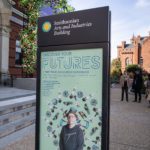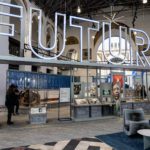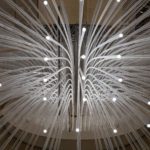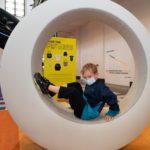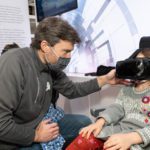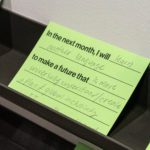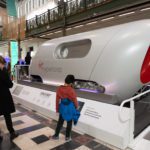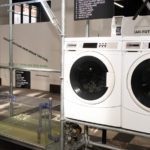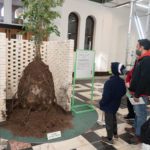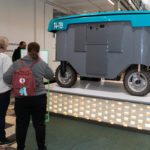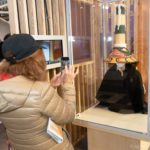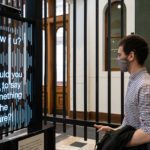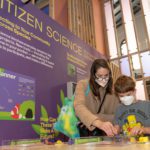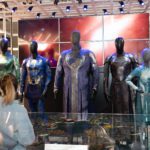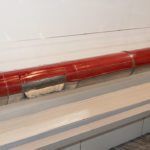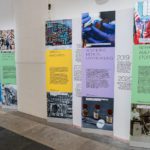Smithsonian Focuses on the Future with New Exhibit (photos)
By • November 21, 2021 0 5011
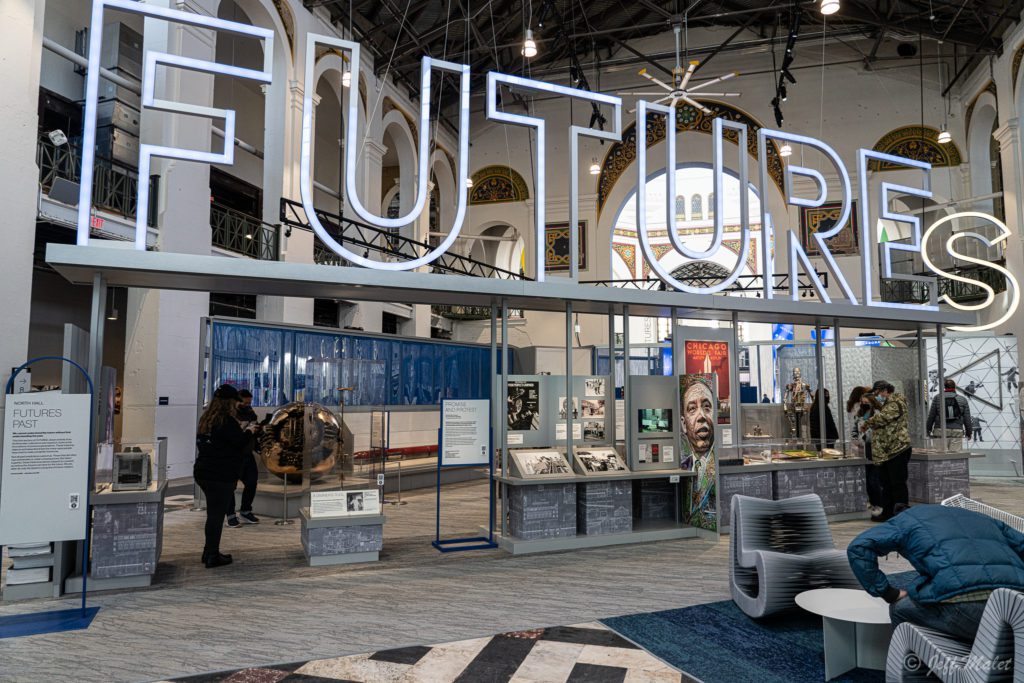
The Smithsonian’s Arts and Industries Building came back to life on Saturday Nov. 20 with “Futures,” an exhibition scheduled to run until July 6, 2022. It will be part of the Smithsonian’s 175th anniversary celebration.
The Smithsonian has long been a central repository of objects from our nation’s past. In Futures, the Smithsonian will be pointing in the other direction – to the world of tomorrow.
The setting is the historic 140 year old Arts and Industries Building (AIB), now reopening in grand fashion after a deep sleep and a major facelift. The AIB first opened in 1881, hosting an inaugural ball for President James A. Garfield. It was the country’s first National Museum (its original name) and is the second oldest (after The Castle) of the Smithsonian buildings on the National Mall in Washington, D.C. But in 2004 the AIB was forced to close its doors due to structural issues. “Futures” is a milestone first step in the long-term plan to renovate and permanently reopen this landmark,” according to a Smithsonian press release.
The future holds many challenges for the planet. Chief among these will be managing our fragile ecosystems under the burden of rising global populations — now nearing 7.9 billion, with estimates projecting it will reach 9.7 billion by 2050. The challenges take two major forms: consumption of resources such as land, food, water, air, fossil fuels and minerals; and waste products as a result of that consumption. Advances in technology and social cohesion provide possible solutions, but only if we act wisely.
Rather than making attempts at prediction, the exhibition emphasizes that there are many possible “futures” (with intentional emphasis on the final letter ‘s’), which will be determined by both individual and collective decisions.
With a 108 foot rotunda at its center, the building is comprised of four pavilions, one at each corner, that are designated “Futures Past;” “Futures that Inspire;” “Futures that Unite” and “Futures that Work.”
This is a collaboration of engineers, artists, writers and designers to envision the possibilities that may lie ahead. Within the Smithsonian’s core mission, “the increase and diffusion of knowledge,” FUTURES will present nearly 32,000 square feet of immersive site-specific art installations, interactives, working experiments, inventions, speculative designs and “artifacts of the future,” as well as historic objects and discoveries from 23 of the Smithsonian’s museums, major initiatives and research centers. With a nod to Covid safety protocols, many of the displays can be activated by body motion or speech rather than by direct touch.
The focal point for the exhibition is a two-story interactive sculpture “we + you” by New York artist and architect Suchi Reddy, incorporating light, color and the latest in artificial intelligence analysis. “The piece is about people expressing their individual agency around the future and showing our collective responsibility for creating a beautiful one together,” Reddy told us. “It takes the word that you’re saying with the emotion and the pitch of your voice and translates that into visual mandala through code that I wrote, and then all your colors go off into the center to be part of the collective.”
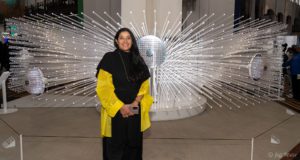
The focal point for the exhibition is a two-story interactive sculpture “we + you” by New York artist and architect Suchi Reddy. Photo by Jeff Malet.
Listed below is a brief sampling of some of the nearly 150 objects currently on display in Futures:
-The Mineral Rover is making its public debut at Futures. Alphabet Inc.’s X lab, the company’s so-called “moonshot factory,” unveiled its Project Mineral about a year ago with a stated goal of finding effective ways to address global food security using what they call “computational agriculture.” The project has focused on a rover-like robot powered by artificial intelligence that can detect weeds and predict yields while synchronizing with satellite imagery, weather data, and ground information, among other things.
-A deli case stocked with cell cultured salmon, lower methane steaks, and insect snacks. On display, a package of the vegetarian MyBacon (“Bacon without the Oink!” it says on the package.)
-An “ecosystem on rinse cycle” features a washing machine using a closed wastewater system to grow a garden of wetland plants.
-A Virgin Hyperloop, which is described as a sealed tube or system of tubes with low air pressure through which a pod may travel substantially free of air resistance or friction that can transport passengers at airline speeds without any direct emissions.
-A replica of a Tinglit clan crest hat digitally restored by Smithsonian staff using state of the art 3D modeling techniques. The hat had been deemed too fragile to restore using ordinary methods.
In the “Futures Past” Hall, one will find on display certain significant historic items from the Smithsonian collection. These represent past visions of the future, some of which were successful, and some as we’ve learned, much less so. They include a 1935 A-Series rocket from pioneer Robert H Goddard. (Today, reusable rockets are once again revolutionizing how we venture into space.) A Morse-Vail Telegraph Key. (The telegraph was the first electronic communications system and the first network. Some have referred to the telegraph as the Victorian internet.) And a 1909 Bakelizer, the pressure vessel used by Leo H. Baekeland to produce commercial quantities of the first totally synthetic plastic, Bakelite. (Of course, not all technology is necessarily good. And while plastics have led to a number of applications that have benefited our lives, plastics are not biodegradable and today we realize that this “dream material” can be a nightmare to the environment. But if materials can be invented, they can also be reinvented.)
The Smithsonian has also commissioned a series of forward-looking shorts by nine award-winning independent film makers exploring social justice issues facing diverse communities across the U.S. to screen during the exhibition. “Each filmmaker hand-selected a grassroots organization for creative collaboration, uplifting stories behind some of the most pressing social justice issues across the U.S., including: healthcare, environment, Indigenous rights, youth incarceration, cultural heritage, immigration, and more.”
Said Brad MacDonald, creative digital media curator for Futures and one of four curators in total: “The exhibit is about framing a positive, more optimistic view of the future. We all have a lot of practice thinking about the future in dystopian terms – everything that could go wrong. But what we don’t practice, what we don’t see in the media, is how things might go right? And the only way things might go right that can serve the needs of as many people as possible is if we start having that conversation and start describing the world we want to live in. This is us. Encouraging people to more effectively describe the world they would like to see in the future.”
“In a world that feels perpetually tumultuous, there is power in imagining the future we want, not the future we fear,” said Rachel Goslins, director of the AIB. “For 175 years, the Smithsonian has been helping people better understand who we are, where we have been and where we want to go. With ‘Futures,’ we want to invite all visitors to discover, debate and delight in the many possibilities for our shared future.”
In the words of Shakespeare: “It is not in the stars to hold our destiny but in ourselves.”
Futures at the Smithsonian Arts and Industries Building will be open every day between 10 a.m. and 5:30 p.m. except Tuesdays, with extended hours Fridays and Saturdays until 7 p.m. Admission is free at The Smithsonian.
View a slideshow of Jeff Malet’s photos from opening day at the Smithsonian’s “Futures” exhibition at the Arts and Industries Building by clicking on the photo icons below.
- The Arts and Industry Building opens its doors at 10 a.m. on Saturday Nov. 20. (photo by Jeff Malet)
- “In a world that feels perpetually tumultuous, there is power in imagining the future we want, not the future we fear,” said Rachel Goslins, director of the AIB. Photo by Jeff Malet.
- The focal point for the exhibition is a two story interactive sculpture “we + you” by New York artist and architect Suchi Reddy. (photo by Jeff Malet)
- An inside look at “we + you” which makes generous use of acrylic tubing and LED lighting. (photo by Jeff Malet)
- A look at the deli of the future featuring cell-based fish and insect protein among other delicacies. (photo by Jeff Malet)
- The Bell Nexus Air Taxi is designed to “let you make the most of your commute.” (photo by Jeff Malet)
- A scale model of Oceanix City, a concept capable of supporting more than 10,000 residents (photo by Jeff Malet)
- Arlo, age 9, from Front Royal Va. is rocking and rolling. (photo by Jeff Malet)
- Emma, age 6, of Arlington Va. tries on VR glasses with help from dad Steve Richard. (photo by Jeff Malet)
- Visitors are encouraged to write what they will do to effect the future. (photo by Jeff Malet)
- The high-speed Virgin Hyperloop Pegasus pod (photo by Jeff Malet)
- Research grade Phase 1 and clinical vials used in 2020 vaccine research. (photo by Jeff Malet)
- An ecosystem on rinse cycle. (photo by Jeff Malet)
- Adrian and son Lionel from Argentina view a Capsula Mundi: biodegradeable burial pod (photo by Jeff Malet).
- Unimate Mark II Industrial Robot: The mineral rover (photo by Jeff Malet)
- Brad MacDonald, creative digital media curator for FUTURES. (photo by Jeff Malet)
- A replica of a Tinglit clan crest hat digitally restored by Smithsonian staff using state of the art 3D modelling techniques. (photo by Jeff Malet)
- Daneil Graff of D.C. interacts by voice. With a nod to COVID safety protocols, many of the displays can be activated by body motion or speech rather than by direct touch. (photo by Jeff Malet)
- The FUTURES We Dream Film Series is a collection of cenematic stories about the futures we hope for and the world we dream of. (photo by Jeff Malet)
- One of the visitors was Wendy Wang of Chantilly Va. Her son Victor Wang of Amazon Web Services provided technical support for “we + you.” (photo by Jeff Malet)
- Citizen Science involves every day people in big research projects. Beth and Will, age 8, of Alexandria Va. participate. (photo by Jeff Malet)
- Marval Studios’s Eternals (photo by Jeff Malet)
- Stephanie and Alessandra , age 3. from Alexandria view an underwater city of the future. (photo by Jeff Malet)
- the Bakelizer—a machine used at the birth of synthetic plastics. (photo by Jeff Malet)
- Morse-Vail Telegraph Key – ancestor of the smartphone (photo by Jeff Malet)
- 1935 A-Series Rocket designed by rocket pioneer Robert H. Goddard. (photo by Jeff Malet)
- The Smithsonian is home to more than 10,000 patent models. including this 1837 silk spinning machine. (photo by Jeff Malet)
- “Futures Past” (photo by Jeff Malet)
- The Smithsonian Arts and Industries Building which opened in 1881 as the country’s first National Museum. (photo by Jeff Malet)

